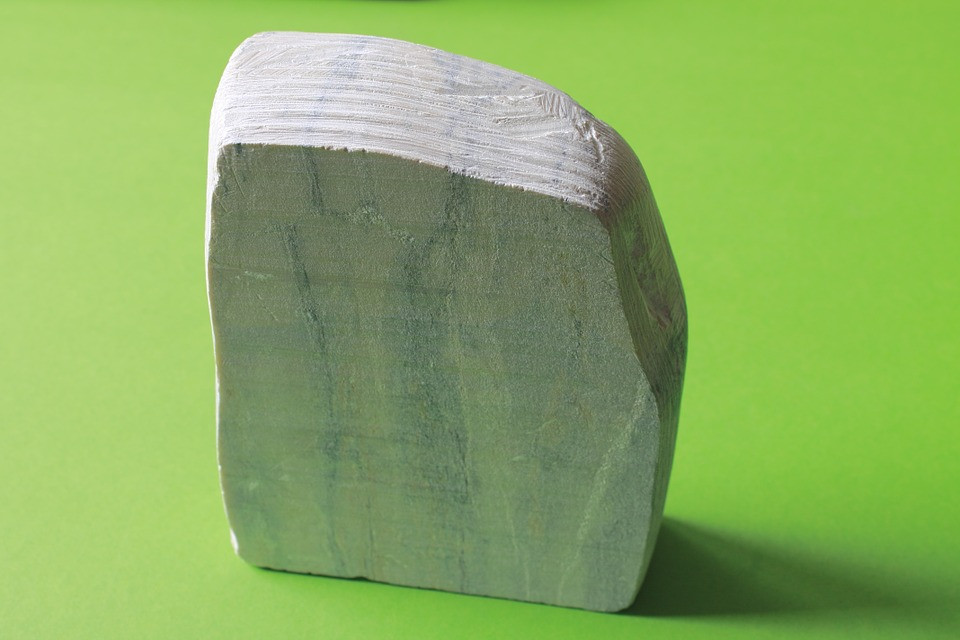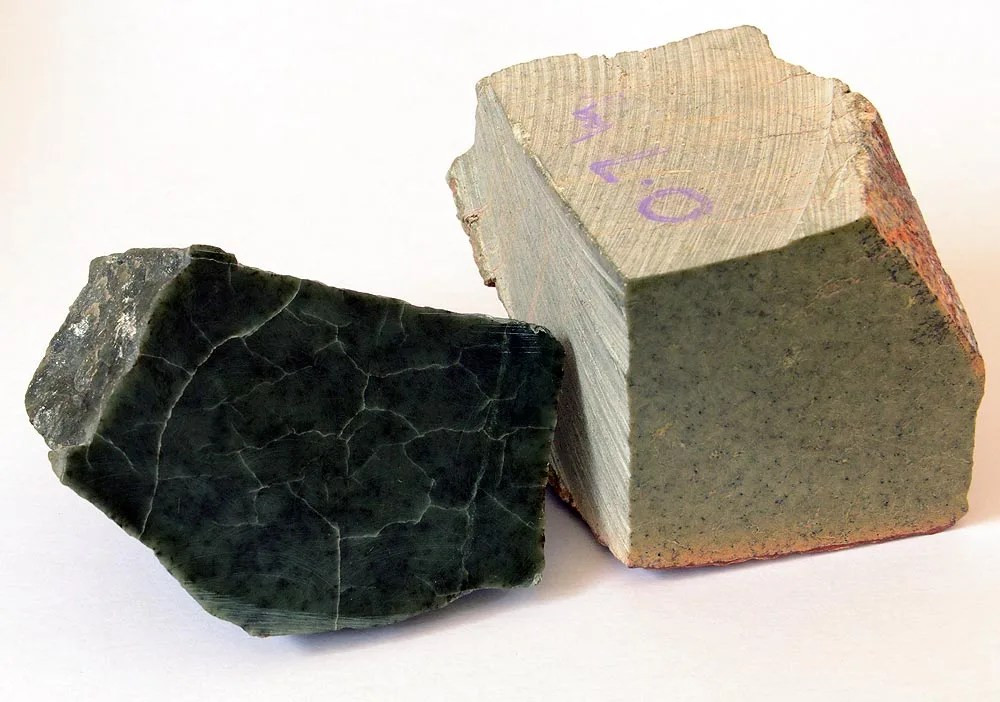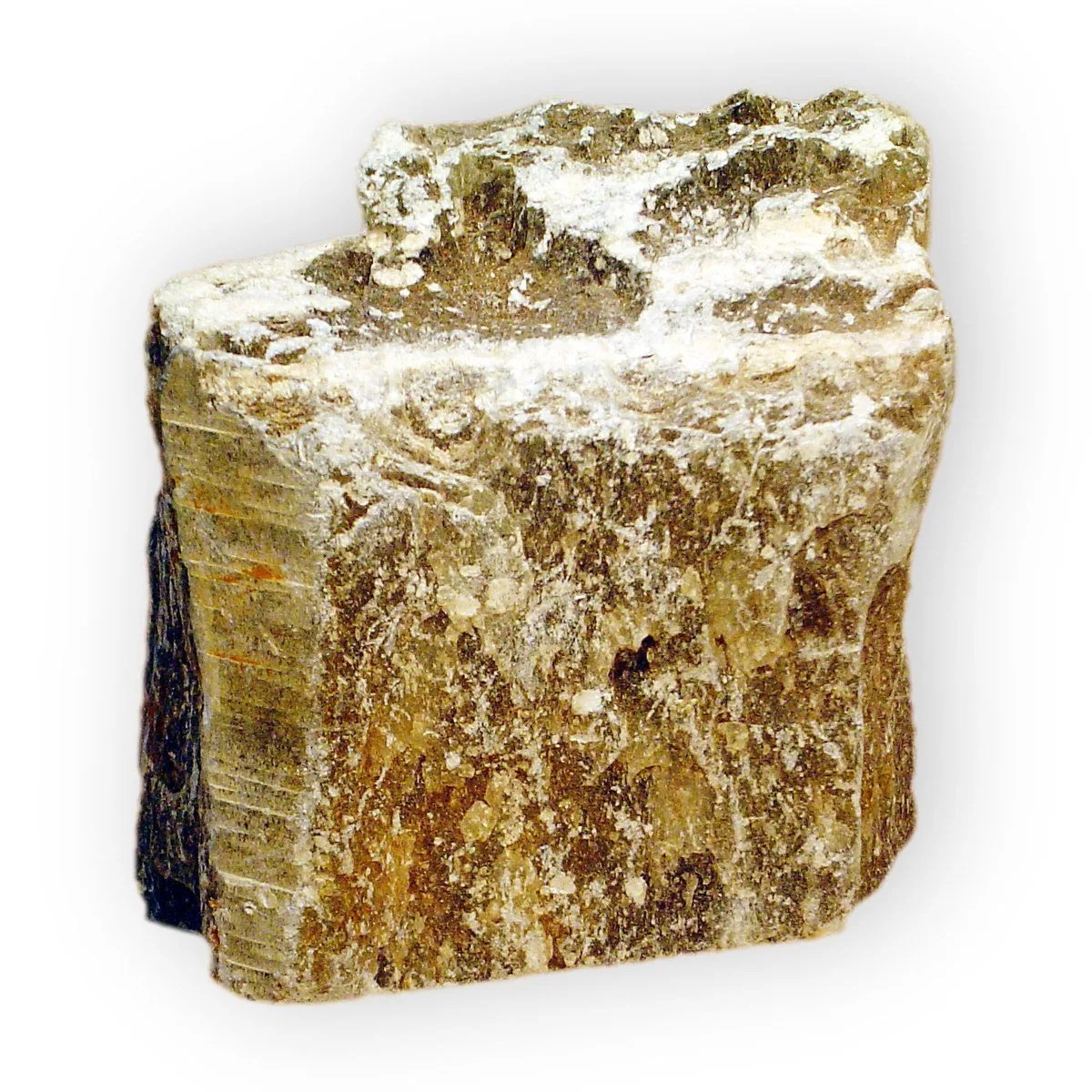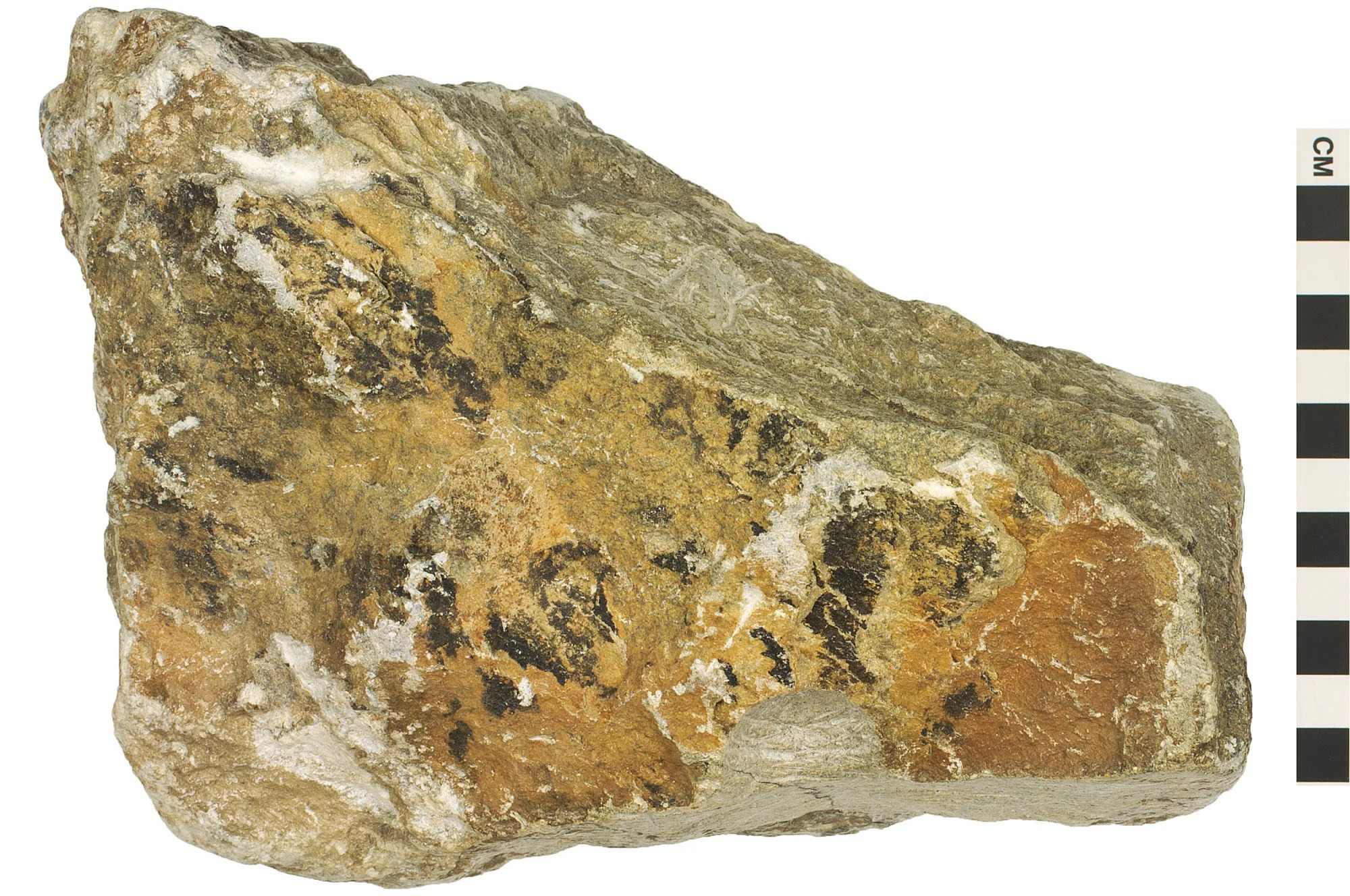Is Soapstone A Mineral Or A Rock? Soapstone, with its smooth, tactile feel, is indeed a metamorphic rock composed primarily of the mineral talc, making it a unique choice for landscaping and artistic applications, as explored on rockscapes.net. This fascinating stone, also known as steatite or soaprock, boasts a composition that includes varying amounts of other minerals like micas, chlorite, and amphiboles, each contributing to its distinctive properties and appearance. Discover how to incorporate this durable and attractive material into your next project with rockscapes.net. We have an abundance of soapstone information, soapstone characteristics and soapstone uses.
1. Understanding Soapstone’s Composition
What exactly makes up soapstone and what minerals are responsible for its unique characteristics?
Soapstone is primarily composed of the mineral talc, but it also contains varying amounts of other minerals like chlorite, amphiboles (tremolite, anthophyllite, and cummingtonite), micas, carbonates, and small traces of iron-chromium oxide. A pure steatite sample would be about 63.37% silica, 31.88% magnesia, and 4.74% water. These additional minerals influence its hardness, color, and overall durability, making each piece of soapstone unique. Understanding the composition of soapstone helps in appreciating its properties and applications in various fields.
2. How Does Soapstone Form in Nature?
Can you explain the geological processes that lead to the formation of soapstone?
Soapstone forms through the metamorphism of magnesium-rich rocks, such as peridotite and pyroxenite. This process involves changes in temperature, pressure, and mineral composition over time. Hydration and serpentinization are key, where minerals like olivine and pyroxenes transform into serpentine minerals with the introduction of water. The serpentine minerals further alter into talc through chemical reactions, giving soapstone its softness and defining characteristics. Regional metamorphism, due to tectonic forces, and contact metamorphism, from direct contact with hot magma, both contribute to soapstone formation.
 Soapstone Formation
Soapstone Formation
3. Where Can Soapstone Be Found Globally?
In what regions of the world is soapstone commonly found, and what makes these locations ideal for its formation?
Soapstone is found in numerous locations worldwide, typically in regions with a history of metamorphic activity and the presence of ultramafic rocks. Notable regions include the United States (Vermont, Virginia, North Carolina, Georgia, California), Brazil (Minas Gerais), India (Rajasthan, Uttar Pradesh, Andhra Pradesh), Finland, Canada (Quebec, Ontario), China, Kenya (Kisii region), Peru (Andes Mountains), and Pakistan (Khyber Pakhtunkhwa, Balochistan). These regions provide the necessary geological conditions, such as suitable parent rocks and the right temperature and pressure conditions for metamorphism, allowing soapstone to form.
 Soapstone Distribution
Soapstone Distribution
4. What Are the Defining Characteristics of Soapstone?
What makes soapstone stand out from other rocks in terms of texture, appearance, and physical properties?
Soapstone’s defining characteristics include its smooth, soapy feel; medium to fine-grained texture; and color variations from light gray to bluish, greenish, or black. It is remarkably soft, making it easy to carve. Soapstone primarily consists of talc, providing heat resistance and thermal properties that make it suitable for stoves and countertops. Its chemical stability and sound absorption properties also enhance its versatility in architectural and design applications. These properties make soapstone a unique and sought-after material for various uses.
5. How is Soapstone Used in Various Applications?
What are the most common uses of soapstone, and what properties make it suitable for these applications?
Soapstone has a wide array of applications, including sculptures and carvings, countertops and surfaces, fireplaces and wood stoves, cookware, sinks and vanity tops, laboratory surfaces, and architectural elements. Its softness and ease of carving make it ideal for sculptures, while its heat resistance and durability make it perfect for countertops and fireplaces. In laboratories, its chemical stability is highly valued. Soapstone’s versatility and unique properties make it a valued material in both artistic and practical fields.
 Soapstone Characteristics and Properties
Soapstone Characteristics and Properties
6. Soapstone vs. Other Stones: What Sets It Apart?
How does soapstone compare to other popular stones like granite and marble in terms of durability, maintenance, and aesthetic appeal?
Soapstone differs significantly from granite and marble. Unlike granite, soapstone is softer and less porous, making it more resistant to staining from substances like tomatoes and wine. While marble offers a classic aesthetic, soapstone provides a more natural, matte finish and superior heat resistance. Soapstone requires regular oiling to maintain its appearance, whereas granite and marble need sealing to prevent stains. In terms of durability, soapstone is less prone to chipping than granite but can scratch more easily due to its softness.
7. Can Soapstone Be Used for Outdoor Landscaping?
Is soapstone suitable for outdoor applications such as garden pathways, retaining walls, or water features?
Soapstone can be used for outdoor landscaping, but its suitability depends on the specific application and environmental conditions. Its resistance to weathering makes it a decent choice for garden pathways and retaining walls. However, it’s essential to consider its softness, as it can be susceptible to scratches and wear over time. For water features, soapstone’s chemical stability ensures it won’t degrade with prolonged exposure to water. Proper installation and maintenance are crucial to ensure its longevity and aesthetic appeal in outdoor settings.
8. What Are the Advantages of Using Soapstone in Kitchens?
How does soapstone enhance the functionality and aesthetics of kitchen countertops and sinks?
Soapstone is a fantastic choice for kitchens due to its heat resistance, chemical stability, and unique aesthetic appeal. It can withstand high temperatures without damage, making it perfect for countertops where hot pots and pans are frequently placed. Its non-porous nature resists staining from common kitchen substances like wine, tomatoes, and coffee. Soapstone also provides a natural, matte finish that complements various kitchen styles, from traditional to modern. Its durability and ease of maintenance make it a practical and beautiful option for kitchen countertops and sinks.
9. The Environmental Impact of Quarrying Soapstone
What are the environmental considerations and sustainability practices associated with soapstone quarrying and processing?
Quarrying soapstone, like any mining activity, has environmental considerations. Sustainable practices include minimizing habitat disruption, managing waste responsibly, and reducing water usage. Restoration of quarry sites post-extraction is also crucial. The environmental impact can be mitigated by adopting best practices in quarry management and adhering to environmental regulations. Choosing soapstone from quarries committed to sustainability helps reduce the overall environmental footprint.
10. How to Care for and Maintain Soapstone Surfaces
What are the best practices for cleaning, sealing, and maintaining soapstone countertops and other applications to ensure longevity?
Maintaining soapstone surfaces involves simple yet effective practices. Regular cleaning with mild soap and water is usually sufficient. Sealing is not typically required due to its non-porous nature, but applying mineral oil can enhance its color and patina. Scratches can be sanded out and re-oiled. Avoid using harsh chemicals or abrasive cleaners. With proper care, soapstone countertops can last for generations, retaining their beauty and functionality.
11. Exploring the Historical Uses of Soapstone
How have different cultures throughout history utilized soapstone for practical and artistic purposes?
Throughout history, soapstone has been utilized by various cultures for its unique properties. Native Americans carved bowls, pipes, and cooking plates from soapstone due to its heat resistance and workability. Scandinavians in the Stone Age used soapstone molds for metal casting. In Brazil, it was famously used in the construction of the Christ the Redeemer statue in Rio de Janeiro. These historical uses highlight soapstone’s versatility and cultural significance.
 The outer layers of the Redeemer sculpture made of soapstone.
The outer layers of the Redeemer sculpture made of soapstone.
12. Soapstone in Art: Carving and Sculpting Techniques
What techniques and tools are commonly used in soapstone carving, and what makes it a preferred material for artists?
Soapstone is a preferred material for artists due to its softness and ease of carving. Common techniques involve using hand tools like chisels, rasps, and sandpaper to shape and refine the stone. The softness allows for intricate details, making it suitable for sculptures, figurines, and ornaments. The final step often involves polishing to bring out its natural luster. Soapstone’s workability and unique texture make it a favorite among sculptors.
13. Enhancing Landscaping with Soapstone: Design Ideas
What are some creative ways to incorporate soapstone into landscape design for aesthetic appeal and functionality?
Soapstone can enhance landscape design in numerous creative ways. It can be used for garden pathways, providing a smooth and natural surface. Soapstone boulders or stacked stones can create visually appealing retaining walls or water features. Smaller pieces can be incorporated into rock gardens or used as edging. Its natural color variations and smooth texture add an elegant touch to any outdoor space, blending seamlessly with the environment.
14. How Does Soapstone Contribute to Sustainable Building?
In what ways does soapstone align with sustainable building practices, and what are its benefits in eco-friendly construction?
Soapstone aligns with sustainable building practices due to its natural abundance, durability, and potential for recycling. Its long lifespan reduces the need for frequent replacements, minimizing waste. Soapstone is also chemically inert, meaning it doesn’t release harmful substances into the environment. Using soapstone in construction supports eco-friendly design by utilizing a natural material with minimal environmental impact.
15. The Impact of Soapstone on Interior Design Trends
How has soapstone influenced interior design trends, and what styles does it complement best?
Soapstone has significantly influenced interior design trends by offering a unique blend of natural beauty and practicality. Its smooth texture and natural color variations complement various styles, from rustic and traditional to modern and minimalist. Soapstone countertops and sinks add a touch of elegance and sophistication to kitchens and bathrooms. Its heat resistance and durability make it a functional choice, aligning with the trend towards sustainable and long-lasting materials in interior design.
16. Grading Soapstone: Quality and Factors
What are the key factors that determine the quality and grade of soapstone for different applications?
The quality and grade of soapstone are determined by several key factors, including mineral composition, density, hardness, and aesthetic appearance. Higher-quality soapstone has a higher talc content, which contributes to its softness and workability. Density affects its durability and heat retention, while hardness determines its resistance to scratches. Aesthetic factors include color consistency, veining patterns, and overall visual appeal. These factors influence its suitability for various applications, from sculptures to countertops.
17. Health and Safety: Soapstone Dust Exposure
What are the potential health risks associated with exposure to soapstone dust, and how can these risks be mitigated?
Exposure to soapstone dust can pose health risks, primarily respiratory issues due to the inhalation of fine particles. Prolonged exposure may lead to lung irritation and other respiratory ailments. These risks can be mitigated by using proper ventilation, wearing respirators or dust masks, and implementing dust control measures during cutting, carving, or sanding. Adhering to safety guidelines and using appropriate protective equipment minimizes the potential health impacts.
18. The Role of Soapstone in Thermal Applications
How does soapstone’s heat retention capability make it valuable in heating systems and cookware?
Soapstone’s exceptional heat retention capability makes it valuable in heating systems and cookware. It can absorb, store, and radiate heat over an extended period, making it ideal for fireplaces, wood stoves, and baking stones. In heating systems, it provides consistent and efficient warmth. In cookware, it ensures even heat distribution, enhancing cooking and baking results. Its ability to withstand high temperatures without damage makes it a safe and reliable choice.
19. Alternatives to Soapstone: Pros and Cons
What are some alternative materials to soapstone, and what are their respective advantages and disadvantages?
Alternatives to soapstone include granite, marble, slate, and engineered stones like quartz. Granite is more durable but requires sealing to prevent stains. Marble offers a classic look but is prone to etching and staining. Slate is durable and water-resistant but has limited color options. Quartz is low-maintenance but lacks the natural feel of soapstone. Each alternative has its own set of advantages and disadvantages, depending on the specific application and aesthetic preferences.
20. Innovations in Soapstone Processing and Manufacturing
What are the latest innovations in soapstone processing and manufacturing techniques that enhance its usability and applications?
Innovations in soapstone processing and manufacturing include advanced cutting techniques, such as CNC machining, which allow for precise shaping and detailing. Improved polishing methods enhance its surface finish and aesthetic appeal. New sealing technologies improve its stain resistance and durability. These innovations expand its usability and applications, making it a more versatile and desirable material in various industries.
21. Soapstone Finishes: Colors and Textures
What types of finishes are available for soapstone, and how do they impact its aesthetic appeal and performance?
Soapstone finishes range from natural, unoiled surfaces to oiled and waxed treatments, each impacting its aesthetic appeal and performance. Natural soapstone has a light gray color and a matte finish. Oiling enhances its color, darkening it to a charcoal gray and bringing out its natural veining. Waxing provides a subtle sheen and added protection. The choice of finish depends on the desired look and the level of maintenance preferred.
22. Soapstone as a Medium for Indigenous Art
How has soapstone been traditionally used by indigenous cultures for artistic expression and cultural preservation?
Soapstone has been traditionally used by indigenous cultures as a medium for artistic expression and cultural preservation. Its softness and ease of carving allow for intricate designs that depict cultural stories, symbols, and beliefs. Soapstone carvings often serve as ceremonial objects, tools, and decorative items, preserving cultural heritage and traditions. Indigenous artists continue to use soapstone to create meaningful and culturally significant artworks.
23. Purchasing Soapstone: Factors to Consider
What are the key considerations when purchasing soapstone, including sourcing, quality, and application requirements?
When purchasing soapstone, key considerations include sourcing, quality, and application requirements. Sourcing from reputable suppliers ensures ethical and sustainable practices. Quality factors include mineral composition, density, and aesthetic appearance. Application requirements determine the specific properties needed, such as heat resistance for countertops or softness for carving. Evaluating these factors ensures you select the right soapstone for your project.
24. The Economic Impact of the Soapstone Industry
What is the economic impact of the soapstone industry on local communities and regional economies?
The soapstone industry has a significant economic impact on local communities and regional economies. It provides employment opportunities in quarrying, processing, and manufacturing. It also supports local businesses that supply tools, equipment, and services. The sale of soapstone products generates revenue that contributes to the economic well-being of the region. Sustainable management of soapstone resources ensures long-term economic benefits.
25. Distinguishing Between Soapstone Varieties
What are the different varieties of soapstone available, and how do their properties and appearances vary?
Different varieties of soapstone vary in properties and appearances based on mineral composition and geological formation. Some varieties are denser and harder, making them suitable for countertops, while others are softer and ideal for carving. Color variations range from light gray to dark green or black, with unique veining patterns. Knowing these distinctions helps in selecting the right type of soapstone for specific applications.
26. Soapstone in the DIY Home Improvement Scene
How can homeowners incorporate soapstone into DIY home improvement projects, and what are some project ideas?
Homeowners can easily incorporate soapstone into DIY projects. Soapstone tiles can be used for backsplashes or accent walls. Soapstone slabs can be transformed into custom countertops or fireplace surrounds. Smaller pieces can be carved into decorative items or used for coasters and trivets. With basic tools and some creativity, soapstone adds a touch of elegance and functionality to any home improvement project.
27. The Future of Soapstone: Trends and Possibilities
What are the emerging trends and future possibilities for soapstone in various industries and applications?
Emerging trends and future possibilities for soapstone include increased use in sustainable building, innovative applications in thermal energy storage, and growing popularity in artistic expression. Advanced processing techniques may lead to new products with enhanced properties. The demand for eco-friendly and durable materials is likely to drive further innovation and expansion in the soapstone industry.
28. Common Misconceptions About Soapstone
What are some common misconceptions about soapstone, and what are the facts that debunk them?
Common misconceptions about soapstone include beliefs that it stains easily, requires constant maintenance, and is not durable. In reality, soapstone is naturally stain-resistant due to its non-porous nature, requires minimal maintenance with occasional oiling, and is highly durable, capable of lasting for generations. These facts debunk the myths, highlighting soapstone’s true benefits.
29. Soapstone’s Sound Absorption Properties
How is soapstone used in architectural acoustics due to its sound-absorbing qualities?
Soapstone’s sound-absorbing properties make it valuable in architectural acoustics. It reduces echo and reverberation, improving sound quality in spaces like recording studios, theaters, and classrooms. Soapstone panels can be integrated into walls and ceilings to absorb sound waves, creating a quieter and more comfortable environment. Its natural aesthetic appeal also enhances the visual design of these spaces.
30. Why Choose Soapstone for Your Project?
What are the compelling reasons to choose soapstone over other materials for your next home or landscaping project?
Choosing soapstone offers several compelling advantages: its unique aesthetic appeal, heat resistance, chemical stability, and sustainability. Its natural beauty complements various design styles, while its durability ensures long-lasting performance. Soapstone’s eco-friendly properties make it a responsible choice for environmentally conscious projects. Whether for countertops, fireplaces, or landscaping, soapstone provides a combination of functionality and elegance that is hard to match.
 Soapstone Applications and Uses
Soapstone Applications and Uses
Conclusion
Soapstone, with its unique blend of mineral composition and metamorphic origins, stands out as a versatile and aesthetically pleasing material. Its heat resistance, workability, and natural beauty make it a favorite for sculptures, countertops, and landscaping projects alike. Now that you know the answer, explore the endless possibilities of incorporating soapstone into your space with inspiration and expert advice from rockscapes.net, where you can discover a wide range of design ideas and find the perfect stones for your next project! Visit us at 1151 S Forest Ave, Tempe, AZ 85281, United States, or give us a call at +1 (480) 965-9011. Let rockscapes.net help you bring your vision to life.